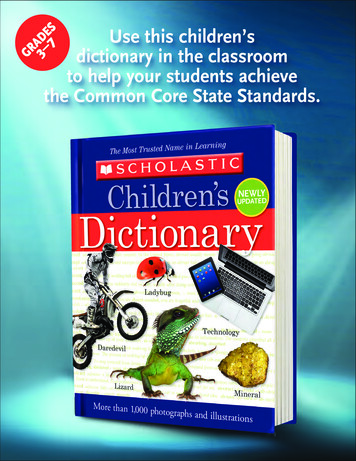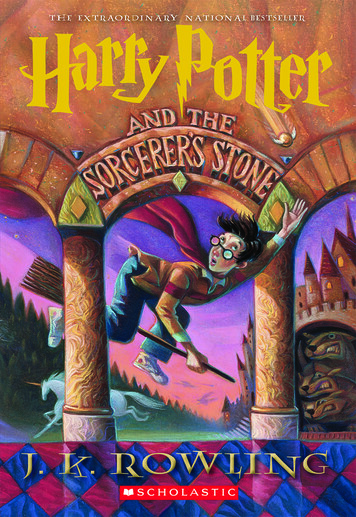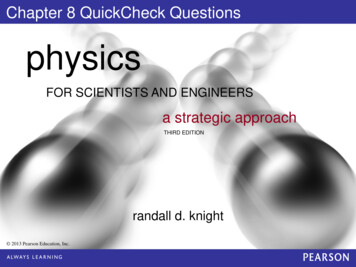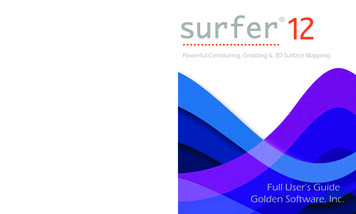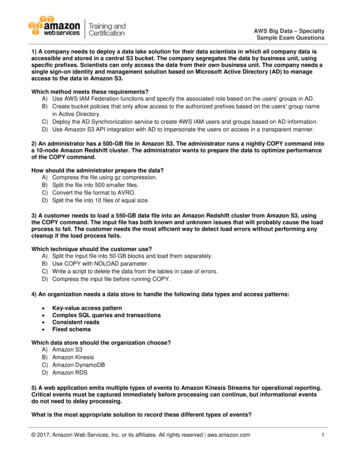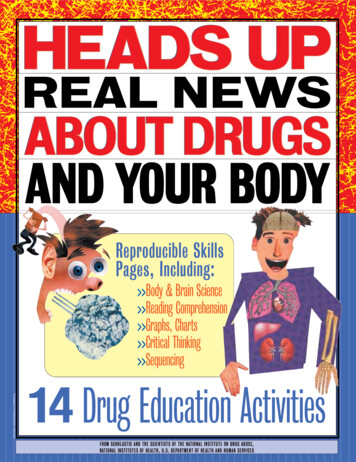
Transcription
STEPHEN KRONINGER(ILLUSTRATION)Reproducible SkillsPages, Including: Body & Brain Science Reading Comprehension Graphs, Charts Critical Thinking Sequencing14 Drug Education ActivitiesFROM SCHOLASTIC AND THE SCIENTISTS OF THE NATIONAL INSTITUTE ON DRUG ABUSE,NATIONAL INSTITUTES OF HEALTH, U.S. DEPARTMENT OF HEALTH AND HUMAN SERVICES
ILLUSTRATIONS BY STEPHEN KRONINGER; BRAIN DIAGRAM (PAGE 2) BY 5W INFOGRAPHICSDear Teacher,One of the most important things you can do as ateacher is to give your students information about thehealth effects of drug abuse. Together with theNational Institute on Drug Abuse (NIDA), we’ve puttogether this 16-page book of reproducibles, full offacts and activities on drugs of abuse. This book is justone component of our ongoing drug educationprogram, “Heads Up: Real News About Drugs andYour Body,” a partnership between NIDA andScholastic Inc. These skills pages can be used alone orto support and extend the feature articles thatappeared in your classroom magazine in the 20022003 school year and are continuing this year.This book includes an introduction to the brain, thatcrucial organ so vulnerable to drugs of abuse. Then,we focus on the health effects of specific drugs,including marijuana, inhalants, nicotine, steroids,prescription drugs, club drugs, heroin, and cocaine.While you can use these reproducibles to support adrug education, health, or human-body sciencecurriculum, the activities extend into other areas. Inorder to complete the activities, students must readcharts and graphs and complete diagrams. They mustread and practice universal skills such as criticalthinking, pre- and post-reading strategies, inferencing,and recall. We hope you find these pages useful acrossyour curriculum.—The Editors For past and current articles in the Heads Up series,as well as activities and teaching support, go to:www.Scholastic.com/HEADSUP For free reprints of the 2002-2003 Heads Up series,call 1-800-729-6686 and refer to NCADI MS927; theaccompanying Teacher’s Edition is NCADI MS928. For free copies of the 2002-2003 Heads Up poster, call1-800-729-6686 and refer to NCADI AVD165.ANSWER KEYBrain, p. 2: Cerebral cortex: thinking,seeing, hearing, and sense of touch; Limbicsystem: produces feelings and emotions;Cerebellum: coordinates movements involvedin everyday tasks; Brain stem: controlsbreathing, food digestion, and heart beat;Nucleus accumbens: involved in reward andfeelings of pleasure. Students’ responsesto how they’ve used each part of the brainwill vary.Marijuana, p. 3: 1. hemp; 2. joint; 3. blunt;4. THC; 5. cannabinoid; 6. neurons;7. hippocampus; 8. cerebellum; 9. cortex;10. dopamine.Inhalants, p. 4: True; False; False; True;False; False; True; False; False; True.Nicotine, p. 6: 1. b; 2. a; 3. c; 4. a; 5. c.Steroids, p. 7: Hair—male-pattern baldness;Bones—stunted growth; Brain/limbicsystem—roid rage; Arm/needle injectionsite—HIV/AIDS; Heart—heart attack;Liver—cysts and liver cancer.Club Drugs, p. 9: Answers can include anyof the effects listed on page 10 under therespective drugs.Cocaine, p. 10: Student answers will vary.Heroin, p. 13: For the correct order of thesentences, start from “What is heroin?” andgo counter-clockwise. Answers for “DrawYour Own Conclusion” may vary.What’s the Question? p. 15: 1. What aresteroids, heroin, and cocaine? 2. What is ahollowed-out cigar filled with marijuana?3. What are MDMA, inhalants, andmarijuana? 4. What is a street name forMDMA? 5. What are MDMA, cocaine,and/or LSD? 6. What are cocaine, heroin,and marijuana? 7. What are LSD, MDMA,and marijuana?Prescription Drugs, p. 16: 1. F; 2. T; 3. F;4. F; 5. T.FROM SCHOLASTIC AND THE SCIENTISTS OF THE NATIONAL INSTITUTE ON DRUG ABUSE, NATIONAL INSTITUTES OF HEALTH, U.S. DEPARTMENT OF HEALTH AND HUMAN SERVICES
ContentsPAGECONTENT2YOUR BRAIN AT-A-GLANCE3THE WORD ON MARIJUANA4-5An introduction to the parts of the brainACTIVITY: Parts of the Brain: What Are They Good For?(Skills: Recall, reading comprehension, inferencing )A glossary of termsACTIVITY: Fill-in-the-Blank(Skills: Recall, reading comprehension, inferencing)THE TOP 10 THINGS YOU NEED TO KNOW ABOUT INHALANTSA list of facts about inhalantsACTIVITY: True or False Quiz(Skills: Recall, reading comprehension)6NICOTINE NEWS7STEROIDS: ALL-OVER HORROR8-9A line graph shows the decline in teen nicotine useACTIVITY: Multiple Choice Quiz(Skills: Graph reading)How anabolic steroids affect the body and brainACTIVITY: The Body on Steroids(Skills: Recall, completing a diagram)RAVE REALITIES: THE TRUTH ABOUT CLUB DRUGSA fact sheet on club drugsACTIVITY: Club Drug Cheat Sheet(Skills: Completing a graphic organizer)10-11THE COCAINE COURSE12-13MIXED-UP ABOUT HEROIN14-15OUTSMART THE CHART16Frequently Asked Questions about cocaineACTIVITY: The Cocaine Course(Skills: Pre- and post-reading strategies)An out-of-order report on heroinACTIVITY: Draw Your Own Conclusion(Skills: Sequencing, drawing conclusions)A comprehensive chart on the common drugs of abuseACTIVITY: What’s the Question?(Skills: Reading a chart, recall, comprehension)A PRESCRIPTION FOR PAINA bar graph of statistics on prescription drug abuseACTIVITY: True or False Quiz(Skills: Reading a bar graph)FROM SCHOLASTIC AND THE SCIENTISTS OF THE NATIONAL INSTITUTE ON DRUG ABUSE, NATIONAL INSTITUTES OF HEALTH, U.S. DEPARTMENT OF HEALTH AND HUMAN SERVICES 1
USES: COPYING MACHINE, OPAQUE PROJECTOR, OR TRANSPARENCY MASTER FOR OVERHEAD PROJECTOR. SCHOLASTIC INC. GRANTS TEACHER-SUBSCRIBERS PERMISSION TO REPRODUCE THIS SKILLS SHEET FOR USE IN THEIR CLASSROOMS. COPYRIGHT 2003 BY SCHOLASTIC INC. ALL RIGHTS RESERVED.Your Brain At-a-GlanceUsing drugs changes the way the brain works. The brain is very important. It controls body functionssuch as breathing, walking, and thinking. Discover the different parts of your brain and the jobs they do.Then, learn how drugs can get in the way. After reading, complete the diagram activity below.The largest part of your brain is the cerebralcortex. When it’s functioning normally, thissection takes care of thinking, seeing, hearing, andthe sense of touch.Next is the cerebellum. The cerebellumcoordinates movements you do everyday, such asbrushing teeth and riding a bike.Just above the spinal cord, a small section ofyour brain called the brain stem controls basicfunctions, such as breathing, digesting food, andmaintaining your heartbeat.Then, there’s the limbic system, also known asthe emotional brain. This is where feelings likefear and passion are born.Scientists have identified a “reward pathway” inthe brain that includes the nucleus accumbens.When we do something that is key to survival,such as eating when we are hungry, the rewardpathway is stimulated. Most addictive drugs alsostimulate this reward pathway, often more thannatural rewards, such as food.How do drugs affect your brain? Once in thebrain, drugs of abuse are similar in size and shapeto brain chemicals called neurotransmitters. Braincells release and absorb these natural chemicals inorder to send and receive messages to and fromeach other. Drugs disrupt this delicatecommunication system, and can hurt your brain.PARTS OF THE BRAIN: WHAT ARE THEY GOOD FOR?For each brain part, write one of the functions it performs. Plus, include one way you’ve used this part of your brain recently.CEREBRAL CORTEXLIMBIC SYSTEMCEREBELLUMNUCLEUS ACCUMBENSBRAIN STEM2 FROM SCHOLASTIC AND THE SCIENTISTS OF THE NATIONAL INSTITUTE ON DRUG ABUSE, NATIONAL INSTITUTES OF HEALTH, U.S. DEPARTMENT OF HEALTH AND HUMAN SERVICES
USES: COPYING MACHINE, OPAQUE PROJECTOR, OR TRANSPARENCY MASTER FOR OVERHEAD PROJECTOR. SCHOLASTIC INC. GRANTS TEACHER-SUBSCRIBERS PERMISSION TO REPRODUCE THIS SKILLS SHEET FOR USE IN THEIR CLASSROOMS. COPYRIGHT 2003 BY SCHOLASTIC INC. ALL RIGHTS RESERVED.The Word on MarijuanaHere are some of the key words you need to understand to discuss the drugmarijuana and its effects. Review the glossary. Then, fill in the blanks in thearticle below.GLOSSARYBlunt: slang term for a cigar filled with marijuanaCannabinoid Receptors: sites on the surface of braincells where the active ingredient in marijuanaattaches to produce the drug’s effectsCerebellum: part of the brain involved in bodymovementHemp: the plant marijuanacomes fromHippocampus: part of thebrain’s limbic system thathelps with learning and memoryJoint: slang term for marijuana rolled into a cigaretteCerebral Cortex: part of the brain involved in higherthinkingNeurons: cells in the brain; also found in the spinalcord and other organsDopamine: a brain chemical (or neurotransmitter)that helps nerve cells communicateTHC: tetrahydrocannabinol, the main activeingredient in marijuanaWHAT IS MARIJUANA? WHAT DOES IT DO TO THE BRAIN?The drug marijuana is the dried, shredded leaves of the plant. While there areseveral methods of use, marijuana is often rolled into a cigarette, called a , orstuffed into a hollowed-out cigar, called a , and smoked.The drug’s effects on the brain are caused by the main active ingredient, tetrahydrocannabinol, or. This chemical attaches to specific receptors in the brain calledreceptors. When it binds to these receptors, it interferes with the normalcommunication between brain cells, or .Several parts of the brain have a lot of these receptors, including the , whichdeals with learning and memory; the , which helps with body movement; andthe cerebral , which is in charge of higher thinking.Finally, research shows that THC triggers the release of , a chemical thathelps nerve cells communicate.FROM SCHOLASTIC AND THE SCIENTISTS OF THE NATIONAL INSTITUTE ON DRUG ABUSE, NATIONAL INSTITUTES OF HEALTH, U.S. DEPARTMENT OF HEALTH AND HUMAN SERVICES 3
USES: COPYING MACHINE, OPAQUE PROJECTOR, OR TRANSPARENCY MASTER FOR OVERHEAD PROJECTOR. SCHOLASTIC INC. GRANTS TEACHER-SUBSCRIBERS PERMISSION TO REPRODUCE THIS SKILLS SHEET FOR USE IN THEIR CLASSROOMS. COPYRIGHT 2003 BY SCHOLASTIC INC. ALL RIGHTS RESERVED.Top 10 Things You Needto Know About InhalantsEducate yourself about this dangerous class of drugs with our Top 10 list below. Then, complete thetrue/false activity on the next page.Household products can be dangerous.1Inhalants are breathable chemical vapors that producemind-altering effects. Some of these come from everydayhousehold products like spray paint, glues, and cleaningfluids. But these toxic chemicals were never meant to beinside a human body!Using inhalants just one time can kill you.23Sniffing highly concentrated amounts of the chemicals insolvents or aerosol sprays can cause heart attacks andeven death within minutes. Known as "Sudden SniffingDeath,” this can happen the first time you use inhalants oranytime after. You can also die from lack of oxygen, sinceyou are filling your lungs with chemicals instead of air.78The destruction could go as deep as insideyour bones. Use of benzene (or gasoline) can damagebone marrow.9Damage can go beyond your brain andbones. Chronic exposure to inhalants can lead tosignificant damage to the heart, lungs, liver, and kidneys.No matter how inhalants are taken, theystill spell danger. Inhalants are breathed in throughthe nose or mouth in a number of ways, variously calledsniffing, snorting, huffing, or bagging. But there is no safeway to breathe toxic fumes.You can lose your hearing for good. Use oftoluene (a chemical found in spray paints and glues) andtrichloroethylene (a chemical found in cleaning fluids andcorrection fluids) can cause hearing loss.Fewer teens are trying inhalants. According to10a recent NIDA-funded study, 17.1 percent of 8th-graderssurveyed had tried inhalants in 2001. In 2002, that numberdecreased to 15.2 percent.Your brain may never be the same again.4The poison in inhalants can kill so many brain cells thatbrain tissue actually shrinks. People who abuse inhalantsmay have difficulty with memory, learning, and thinking.When you hurt your brain, you hurt yourbody. Inhalants dissolve the protective coating called5myelin on neurons, or brain cells. Myelin helps messagestravel rapidly along nerve cells. When myelin is damaged,messages move too slowly—resulting in muscle spasms,tremors, and even difficulty walking and talking.By using inhalants, you risk depression.6Inhalants can affect an abuser’s mood even when he or sheis not huffing. The sniffer can fall into a gloomy moodwhere nothing about life seems good or hopeful—acondition doctors call depression.4 FROM SCHOLASTIC AND THE SCIENTISTS OF THE NATIONAL INSTITUTE ON DRUG ABUSE, NATIONAL INSTITUTES OF HEALTH, U.S. DEPARTMENT OF HEALTH AND HUMAN SERVICES
USES: COPYING MACHINE, OPAQUE PROJECTOR, OR TRANSPARENCY MASTER FOR OVERHEAD PROJECTOR. SCHOLASTIC INC. GRANTS TEACHER-SUBSCRIBERS PERMISSION TO REPRODUCE THIS SKILLS SHEET FOR USE IN THEIR CLASSROOMS. COPYRIGHT 2003 BY SCHOLASTIC INC. ALL RIGHTS RESERVED.True or False?What’s the truth? Read these statements about inhalants. Mark “T” for statements you think are true,and “F” for statement you think are false. Then, double-check your answers by reviewing what you readin “Top 10 Things You Need to Know About Inhalants.”Inhalants can cause heart attacks.Aerosol sprays are not toxic.Toluene (a chemical found in spray paints) is the only harmless inhalant.Inhalant abusers are at risk for depression.According to a 2002 study, more than 50% of 8th-graders surveyedhad tried inhalants.Inhalants help speed messages through nerves by building myelin.Inhalants can cause permanent hearing loss.Sniffing chemicals through the nose is safe; inhaling through themouth is not.“Huffing” refers to a safe method of inhaling chemical fumes.Inhalants can cause kidney damage.FROM SCHOLASTIC AND THE SCIENTISTS OF THE NATIONAL INSTITUTE ON DRUG ABUSE, NATIONAL INSTITUTES OF HEALTH, U.S. DEPARTMENT OF HEALTH AND HUMAN SERVICES 5
There’s good news about cigarettes and teens. Fewer 12th-, 10th-, and 8th-graders smoked cigarettesin 2002 than in 2001. Teen smoking has gone down in popularity for five years in a row. Check out the linegraph below. Then, take the multiple-choice quiz that follows.40%1998Percentage of Teens Who Use Nicotine (1997-2002)30%199920002001200220%12th grade10th grade8th grade10%0%SOURCE: MONITORING THE FUTURE, 20021997Percentage of 12th-, 10th-, and 8th-graders whosmoked cigarettes in the last 30 days, 1997-2002USES: COPYING MACHINE, OPAQUE PROJECTOR, OR TRANSPARENCY MASTER FOR OVERHEAD PROJECTOR. SCHOLASTIC INC. GRANTS TEACHER-SUBSCRIBERS PERMISSION TO REPRODUCE THIS SKILLS SHEET FOR USE IN THEIR CLASSROOMS. COPYRIGHT 2003 BY SCHOLASTIC INC. ALL RIGHTS RESERVED.Nicotine News1997199819992000Year20012002MULTIPLE CHOICE QUIZ1. What does this graph show?3.12th gradea. What percentage of students in 8th, 10th,10th gradeand 12th grade did their homework inthegrade8thyear 2002.b. What percentage of students in 8th, 10th,and 12th grade smoked in the last month,for the years 1997-2002.4.c. Reasons teens give for smoking.2. From 1997-2002, how has the percentage ofteen smokers changed?a. It’s gone down every year in each grade.b. It’s gone down every year, except for 2000.c. It went down for only 8th- and 10thgraders.Which grade of students, in which year, hasthe least percentage of smokers?a. 10th-graders, 1997b. 12th-graders, 2000c. 8th-graders, 2002From 1997 to 2002, how much of a percentagedrop has there been for 12th-graders who saythey have smoked in the last month?a. about 10 percentb. about 5 percentc. about 30 percent5. What grade students were part of this survey?a. Middle school studentsb. 9th- and 11th-grade studentsc. 8th-, 10th-, and 12th-grade students6 FROM SCHOLASTIC AND THE SCIENTISTS OF THE NATIONAL INSTITUTE ON DRUG ABUSE, NATIONAL INSTITUTES OF HEALTH, U.S. DEPARTMENT OF HEALTH AND HUMAN SERVICES
USES: COPYING MACHINE, OPAQUE PROJECTOR, OR TRANSPARENCY MASTER FOR OVERHEAD PROJECTOR. SCHOLASTIC INC. GRANTS TEACHER-SUBSCRIBERS PERMISSION TO REPRODUCE THIS SKILLS SHEET FOR USE IN THEIR CLASSROOMS. COPYRIGHT 2003 BY SCHOLASTIC INC. ALL RIGHTS RESERVED.Steroids: All-Over HorrorSome people take drugs called steroids illegally as a way to build their muscles. But steroids affectmore than muscles. Read below how steroids mess with your brain and body. Then, finish the diagram.Write either how steroids affect the body part indicated by an arrow, or the name of the body part affected. Anabolic steroids are artificialversions of the male sexhormone testosterone. Artificialhormones affect the body inseveral ways. Men, for example,can grow breasts. And womencan grow facial and excessivebody hair, and get deep voices.Both sexes can experiencemale-pattern baldness.Changed for the Worse(body part)male-pattern baldness(side effect)limbic system(body part)(side effect)heart(body part) The drugs may also causestunted growth in teens.When the brain senses too muchof a hormone, it signals thebones to stop growing, even at ayoung age. Anabolic steroids causeproblems in the brain, as well.They affect the limbicsystem, a part of the brainconnected with mood. Someusers experience very violentfeelings. This condition isknown as roid rage. Most steroid users pop pillsbut some inject the drugs.When they share needles, thiscan lead to the spread of HIVand AIDS.injection by needle(body part)(side effect)(side effect)(body part)cancer(side effect)bones(body part)(side effect) Finally, steroids make theirway to the heart, causingpotentially fatal heartattacks. They also passthrough the liver, causing cystsand possibly liver cancer.FROM SCHOLASTIC AND THE SCIENTISTS OF THE NATIONAL INSTITUTE ON DRUG ABUSE, NATIONAL INSTITUTES OF HEALTH, U.S. DEPARTMENT OF HEALTH AND HUMAN SERVICES 7
USES: COPYING MACHINE, OPAQUE PROJECTOR, OR TRANSPARENCY MASTER FOR OVERHEAD PROJECTOR. SCHOLASTIC INC. GRANTS TEACHER-SUBSCRIBERS PERMISSION TO REPRODUCE THIS SKILLS SHEET FOR USE IN THEIR CLASSROOMS. COPYRIGHT 2003 BY SCHOLASTIC INC. ALL RIGHTS RESERVED.Rave Realities:The Truth About Club DrugsSome teens go to all-night dances, called raves or trances. Some like to party at clubs. Many of theyoung people who are into the club and dance scene don’t do drugs. But some do. They may be attracted toclub drugs like MDMA (ecstasy) because they promise increased stamina for hours of dancing and intoxicatinghighs. But what these teens don’t know may hurt, or even kill, them. Here are the facts on club drugs.MDMA (Ecstasy)The so-called “love drug” can causepsychological problems like confusion,depression, sleep problems, and severeanxiety. MDMA can also cause physicaldifficulties, such as faintness, nausea, muscletension, blurred vision, involuntary teethclenching, and chills or sweating. MDMA canalso cause severe overheating. In rare cases,this has led to death in MDMA users. Someside effects of MDMA don’t go away whenthe drug wears off. Depressed feelings canemerge several days after MDMA is taken.Animal studies show that MDMA can causebrain damage; this may also occur in people.LSDA hallucinogen, LSD causes extreme changesin sensory perceptions. Also known as acid,the drug produces physical effects includingtremors, sleeplessness, dry mouth, dilatedpupils, loss of appetite, and increased heartrate and blood pressure. People taking LSDmay also lose touch with reality. For example,they may see or hear things that aren’t there(hallucinations). They may also have bizarreor paranoid thoughts and act on them, causinginjury to themselves or others. Users may alsohave perception problems, sometimes calledflashbacks, that may come and go for a longtime after they take LSD. For example, theymay see trails of lights that aren’t there or feellike the room is spinning.MethamphetamineThis highly addictive drug has many streetnames—speed, ice, chalk, meth, crystal,crank, fire, and glass. It’s a stimulant withmany serious health risks. Methamphetaminecan cause memory loss,
from scholastic and the scientists of the national institute on drug abuse, national institutes of health, u.s. department of health and human services1 contents 2 3 4-5 6 7 8-9 10-11 12-13 14-15 16 page content your b
